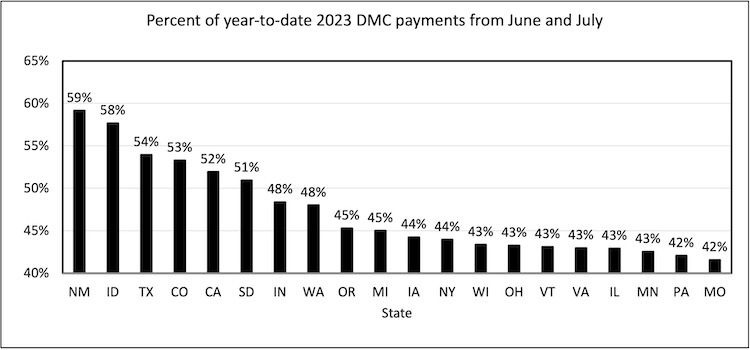
Though the calendar has not yet turned to fall, the Dairy Margin Coverage (DMC) program has already eclipsed the $1 billion mark in payments for 2023. Expected payments as of September 5 are now at $1.13 billion, nearing the previous DMC record payout of $1.19 billion in 2021. Though year-to-date payment levels are similar to the 2021 total on a national scale, the state-by-state distribution of these payments has changed.
Total U.S. payments from the first seven months of 2023 are only 5% below the 2021 total, but payments to Missouri producers are 24% less. Other states in the top 20 for year-to-date DMC payments that are well below 2021 levels include Oregon (-14%), Virginia (-13%), Illinois (-12%), Minnesota (-11%), and Vermont (-11%). Meanwhile, Idaho producers have already accumulated 21% more payments than in all of 2021, followed by Texas (+19%), South Dakota (+15%), and California (+10%).
Though there are many reasons why the distribution of payments would change from year to year, the fact that June and July DMC margins were below $4 — the coverage level that requires no premium payments regardless of production history quantity — appears to be the biggest factor driving the changes. The lowest monthly DMC margin in 2021 was $5.03.
Since USDA’s Farm Service Agency provides snapshots throughout the year of accumulated DMC payments, it is possible to calculate the share of year-to-date payments that each state accumulated during June and July. On a national level, nearly 46% of year-to-date DMC payments were accumulated due to June and July margin levels. The figure below shows the percentage by state for the top 20 payment-receiving states in 2023.
Ordering the states in this fashion highlights the fact that states with relatively larger dairy operations have qualified for a larger share of year-to-date payments since margins have dropped below $4 per cwt. While this is not surprising given the premium structure of the DMC program, it does provide more food for thought to those currently working to construct the next farm bill’s dairy safety net.









